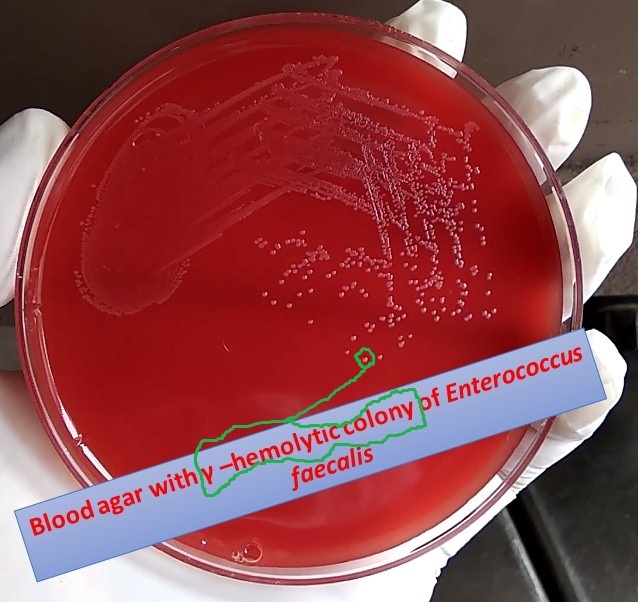Blood agar with gamma hemolytic colony: Enterococci and their detail

Gamma hemolytic colony
5% sheep blood agar (BAP) is with gamma (γ) hemolytic i.e. non hemolytic colony of Enterococcus faecalis as shown above picture. Enterococci are small (less than 1 mm) or pin point colony and catalase test negative.
Classification of Enterococcus
Scientific classification
Domain: Bacteria
Phylum: Firmicutes
Class: Bacilli
Order: Lactobacillales
Family: Enterococcaceae
Genus : Enterococcus
Species: Enterococcus faecalis and E. faecium
Introduction
Streptococci belonging to group D are classified as enterococcci and they are usually non-hemolytic while some strains may be alpha or beta hemolytic. This enterococci group has been classified in 1984 as a separate genus called Enterococcus based on nucleic acid hybridization studies that showed a more distant relationship to the streptococci. The genus Enterococcus contains over 50 species. They are normal flora of human intestinal tract. E. faecalis and E. faecium are medically important species.
Morphology
Gram positive cocci in pairs and short chains. They are non motile (except , E. gallinarum and E. casseliflavus) non-capsulated and non- sporing.
Culture
Blood agar: They are ususally non-hemolytic or gamma ( as shown above image) where as some strains may be alpha or beta hemolytic.
MacConkey agar: On MacConkey agar without crystal violet they grow as tiny deep pink colonies.
Note: Types of MacConkey agar are as follows-
MacConkey agar without bile salt and crystal violet : for both Gram positive and negative bacteria
MacConkey medium with bile salt: For mainly Gram negative bacteria but Enterococci may also be grown.
MacConkey medium with both bile salt and crystal violet : Only for Gram negative rods
Biochemical Reactions
- They are able to grow in the presence of 40% bile and 6.5% sodium chloride .
- Similarly, their ability to grow at 45°C and at pH 9.6.
- They are PYR test positive.
- E. faecalis is the most commonly isolated enterococcus from human sources. Other enterococci are E. faecium and E. durans. E. faeclais can be identified by fermentation of mannitol, sucrose, sorbitol and aesculin and by producing black colonies when grown on tellurite blood agar.
Resistance
They have the ability to grow over wide-temperature and pH ranges, survive desiccation, and grow in the presence of 6.5% NaCl and 40% bile salts.
Pathogenecity
Their ability to cause –
- Bacteremia
- Urinary Tract Infection
- Endocarditis
- Surgical site infections
- Root canal failure
- Immune evasion
- Tissue Damage
- Toxic Metabolites
Lab Diagnosis of Enterococci
Enterococci can be isolated as follow-
- Pin point gamma i.e. non-hemolytic colonies on blood agar except some
- Catalase test : Negative
- Bile esculin test : Positive
- Growth in 6.5% sodium chloride and at pH 9.6
- Growth at 10°C and 45°C
- Pyruvate fermentation test
- Acetoin production test
- Litmus milk decolorization test
- PYRase test
- Reduces potassium tellurite test
- Reduces triphenyltetrazolium chloride (TTC) test
Treatment
Enterococci resistant to penicillin and other antibiotics occur frequently. Vancomycin is the primary alternative drug to a penicillin for treating enterococcal infections. Vancomycin Resistant Enterococcus (VRE) has also been isolated. Resistance is most common in E. faecium but vanocomycin resistant strains of E. faecalis also occurs.
References
- https://www.ncbi.nlm.nih.gov/pmc/articles/PMC6629438/
- Bailey & Scott’s Diagnostic Microbiology. Editors: Bettey A. Forbes, Daniel F. Sahm & Alice S. Weissfeld, 12th ed 2007, Publisher Elsevier.
- Clinical Microbiology Procedure Hand book Vol. I & II, Chief in editor H.D. Isenberg, Albert Einstein College of Medicine, New York, Publisher ASM (American Society for Microbiology), Washington DC.
- Colour Atlas and Text book of Diagnostic Microbiology. Editors: Koneman E.W., Allen D.D., Dowell V.R. Jr and Sommers H.M.
- Jawetz, Melnick and Adelberg’s Medical Microbiology. Editors: Geo. F. Brook, Janet S. Butel & Stephen A. Morse, 21st ed 1998, Publisher Appleton & Lance, Co Stamford Connecticut.
- Mackie and Mc Cartney Practical Medical Microbiology. Editors: J.G. Colle, A.G. Fraser, B.P. Marmion, A. Simmous, 4th ed, Publisher Churchill Living Stone, New York, Melborne, Sans Franscisco 1996.
- Manual of Clinical Microbiology. Editors: P.R. Murray, E. J. Baron, M. A. Pfaller, F. C. Tenover and R. H. Yolken, 7th ed 2005, Publisher ASM, USA
- Text book of Diagnostic Microbiology. Editors: Connie R. Mahon, Donald G. Lehman & George Manuselis, 3rd edition2007, Publisher Elsevier.
- Topley & Wilsons Principle of Bacteriology, Virology and immunology Editors: M.T. Parker & L.H. Collier, 8th ed 1990, Publisher Edward Arnold publication, London.
- Medical Microbiology-The Practice of Medical Microbiology Vol-2-12th Edn. –Robert Cruickshank
- District Laboratory Practice in Tropical Countries – Part-2- Monica Cheesebrough- 2nd Edn Update
- https://en.wikipedia.org/wiki/Enterococcus
